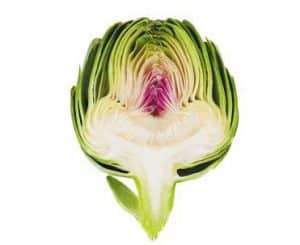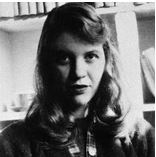Interpreting poetry is analogous to exploring the layers of an artichoke blossom. My least favorite way to analyze a poem is to consider the elements of rhyme, meter, form, and sound devices (alliteration, consonance, assonance, onomatopoeia), so let’s categorize those aspects as the somewhat prickly, harsh-looking outer shells of each petal of the artichoke. On rare occasions, I have found poems whose structure and theme form a perfect union (such as Jean Toomer’s “Portrait in Georgia,” Langston Hughes’ “A Dream Deferred,” and T. S. Eliot’s “The Hollow Men”), but unless we are analyzing a sonnet or an ode, do we really need to obsess about rhyme, meter, stanza variations, or types of poems, all elements that reside on the surface of a poem, just as the thorny outer shell of the artichoke petal resides on the exterior of the blossom? With minimal guidance, most people will be able to analyze metric patterns (i.e., iambic pentameter), rhyme (i.e., internal, end, feminine), stanza form (i.e., octave, sestet, couplet), and sound devices, but fewer people will be able to interpret the meaning of a poem.
The tender inner surface of each petal is edible and delicious, appealing primarily to our senses of taste and touch. Poems contain imagery, defined by Laurence Perrine in Sound and Sense as “the representation through language of sense experience.” Readers should look beyond visual images to find words and phrases that evoke auditory, tactile, kinesthetic, and olfactory responses. Eve Merriam, in her poem “How to Eat a Poem,” encourages the reader to “Bite in./Pick it up with your fingers and lick the juice that/may run down your chin.”
 As a person eating an artichoke must peel back the petals to arrive at the heart, readers who want to explore beyond the five senses need to pull back the layers of a poem to arrive at its heart, or deeper meaning embedded in figurative language (i.e., symbols, metaphors, allusions, similes, personification, paradox, understatement, hyperbole, irony). Elitist Modernists such as Eliot, Stevens, and Yeats utilized private symbols that were much more difficult to decipher than universal symbols such as water (purification) or a dove (peace). Many poems contain Biblical allusions, and to discover them, one does not have to be a Biblical scholar. Usually, the archetypes of good (God) and evil (Satan) are those that appear frequently in poetry and are easily perceived. One of the most famous metaphors in Imagist poetry appears in Ezra Pound’s “In a Station at the Metro,” a two-line poem which Pound considered a work of first intensity.
As a person eating an artichoke must peel back the petals to arrive at the heart, readers who want to explore beyond the five senses need to pull back the layers of a poem to arrive at its heart, or deeper meaning embedded in figurative language (i.e., symbols, metaphors, allusions, similes, personification, paradox, understatement, hyperbole, irony). Elitist Modernists such as Eliot, Stevens, and Yeats utilized private symbols that were much more difficult to decipher than universal symbols such as water (purification) or a dove (peace). Many poems contain Biblical allusions, and to discover them, one does not have to be a Biblical scholar. Usually, the archetypes of good (God) and evil (Satan) are those that appear frequently in poetry and are easily perceived. One of the most famous metaphors in Imagist poetry appears in Ezra Pound’s “In a Station at the Metro,” a two-line poem which Pound considered a work of first intensity.
“In a Station at the Metro”
The apparition of these faces in the crowd;
Petals on a wet, black bough.
 Right above the artichoke heart is the choke, a crown of pointy fibers that look like hair. I liken these “pointy” fibers to connections that an avid reader of poetry makes among poets and poems or the connection the poet wishes to make with his/her readers. It is exciting to connect a theme, motif, or symbol from one poem to another or from an entry in a poet’s journal to a line in one of the poet’s poems. In Sylvia Plath’s “The Rabbit Catcher,” which most critics consider an indictment of her marriage to Ted Hughes, there is a seemingly inexplicable line that reads, “The glassy light was a clear wall,” but in a journal six months before her death, she wrote of feeling “outcast on a cold star, unable to feel anything but an awful helpless numbness. I look down into the warm, earthy world. Into a nest of lovers’ beds, baby cribs, meal tables, all the solid commerce of life in this earth, and feel apart, enclosed in a wall of glass.” Monologue At 3 AM
Right above the artichoke heart is the choke, a crown of pointy fibers that look like hair. I liken these “pointy” fibers to connections that an avid reader of poetry makes among poets and poems or the connection the poet wishes to make with his/her readers. It is exciting to connect a theme, motif, or symbol from one poem to another or from an entry in a poet’s journal to a line in one of the poet’s poems. In Sylvia Plath’s “The Rabbit Catcher,” which most critics consider an indictment of her marriage to Ted Hughes, there is a seemingly inexplicable line that reads, “The glassy light was a clear wall,” but in a journal six months before her death, she wrote of feeling “outcast on a cold star, unable to feel anything but an awful helpless numbness. I look down into the warm, earthy world. Into a nest of lovers’ beds, baby cribs, meal tables, all the solid commerce of life in this earth, and feel apart, enclosed in a wall of glass.” Monologue At 3 AM
Similarly, there is an uncanny connection between one of Sylvia Plath’s 1958 journal entries following her commitment to a mental institution and T.S. Eliot’s philosophy of life, as expressed by him in the early 1900’s. Plath described her stay in the hospital as “[a] time of darkness, despair, and disillusion–so black only as the inferno of the human mind can be–symbolic death, and numb shock–then the painful agony of slow rebirth and psychic regeneration.”
Sylvia Plath Quotes
Eliot “sees the choice for civilized man as between the pain of spiritual stagnation or the willing surrender to purgation, to the heavy toil of spiritual rebirth.
T.S. Eliot’s approach to poetry (See page 6)
Another interpretation of the choke (the connection between poet and reader) lies in the failed quest of the British Romanticists, especially Wordsworth, Shelley, and Keats. Those poets wanted their poems to change society, and they became frustrated when society didn’t harken to their every word. When Shelley wrote the following lines of “Ode to the West Wind,” in 1819, he was invoking the Wind to enable him to change mankind through his poetry:
Drive my dead thoughts over the universe
Like wither’d leaves to quicken a new birth!
And, by the incantation of this verse,
Scatter, as from an unextinguish’d hearth
Ashes and sparks, my words among mankind!
Be through my lips to unawaken’d earth
The trumpet of a prophecy!
The stem from which the artichoke blossom emerges is the chord that binds the poem to the reader. The interpretation of a poem often is highly personal, as is the reaction to the poem (“I love it,” or “I hate it.”) If you prefer not to be so analytical, you should just read poetry and decide how each poem makes you feel. If you feel disgust, that is probably what the poet wanted you to feel; if you feel joy, again, that is what the poet probably meant for you to feel. If you feel nothing, perhaps you should find another poet or poem to enjoy. And, for the record, you do not have to love artichokes to love poetry; you just have to be willing to look below the surface of the poem to find any meaning to which you might relate on an emotional, intellectual, or aesthetic level.
Mangia!

Recent Comments